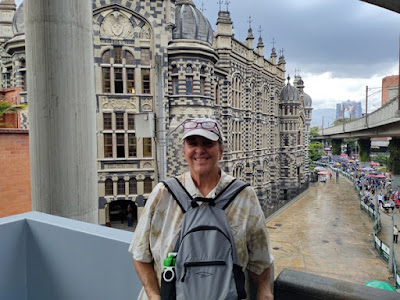Beyond Cartagena Aug 2023
As we left town, we started seeing these animal road signs. We never saw the animals, but someone made the signs to warn drivers that they might be around. There were a couple of monkey ones and they often build monkey bridges--hanging ladder-nets-- over the road to let them get across without entering traffic.
There were a couple of differnt depictions of iguanas as well.
There were also signs for anteaters, cows, snakes, bulls, raccoons, and probably more I didn't capture from the car as we drove by.
Along the port road in Cartagena, there were thousands of pallets stacked 20-30' high. Men were selling them and using them to make furniture. I guess the port is glad to get rid of them once the shipped merchandise is offloaded.
We still saw horse carts being used on the roads. They usually keep to the right lane and vehicles just have to swerve around them.Tall ornate church spires as we drove through Baranquilla, up along the coast.
This biplane was just a decoration along the port road in Baranquilla.
We stopped at the Totuma Mud Volcano on our way to Santa Marta. People flock here to climb into the mud in the little hill of a volcano. It's supposed to do wonders for your skin and folks dunk themselves wholly into the mud pit. You have to pay to climb the ladder to get to the caldera of mud, so I wasn't in any shape to do it, and Jason didn't want to get all muddy.People wandered around covered in mud.
I guess he's letting it all dry on him.
This guy is covered in wet mud, leaving sloppy tracks down to the lagoon to get washed off. Other people at our hostel said they had to wait nearly an hour to get up the ladder, which made it a disappointment of a trip, but this day, the bus was just leaving and we could've just walked up. You can also buy a bottle of the mud to take with you.
People washing off the mud from Totuma in the lagoon just down the hill. Locals would also give you a massage as they rubbed the mud off of you if you wanted.
A mountain lake comes into view.This tall building had multi-colored lights on it, making it a pretty sight on a rainy night in downtown Medellin.
The clouds crawled down the mountain at altitude.Locals were cutting trees and millilng them on site, tossing the cut lumber down the side of the hill to the road to be picked up and loaded onto a truck.
Not exactly safety minded, here a welder is working with a torch next to a gas pump that is still actively serving customers.
We tried our hand at 'tejo', the national sport of Colombia, even though few folks have heard of it outside the country. Here, Jason is perfecting his technique for throwing a steel disk towards packets of phosphorous set in a bed of clay. The idea is to hit the packets onto a steel ring in the clay and make them explode.
Chris, our instructor. He's the only gringo who teaches the game and is one of the top 5 players in the country.
Jason with his steel tejo and the packet he got to explode.
Karen holding her first exploded packet. You dig your tejo out of the clay after each throw and wipe it off with an old onion bag so it doesn't slip out of your grasp when you toss it.
Jason and Karen in front of the tejo field of clay in Medellin.
Tejos and mechas, the exploding packets. Most people think they're filled with gunpowder, but it's phosphorous. They're difficult to obtain and illegal in the USA. Nobody would insure the proprietors of such a game in America.
The steel tejos weigh a little over 2 pounds. Professionals can get them up to 3 lbs.
Chris was fun to play and learn with for a couple of hours.
Karen in Medellin at the train station after our cable car ride. A pretty church in the background, but the rain and my sore foot kept us from exploring much more this day.
A chameleon painted on a rooftop was a cute view from the cable car in Medellin.
Fancy cookies/macarons at a shop at the top of the cable car ride in Medellin.
We grabbed some ham and cheese rolls at the top as a snack to tide us over.
An interesting mural in the town at the top of the cable car ride. Most murals are so colorful, this one in black, white and silver caught my eye.
Medellin is absurdly huge and sprawls up the sides of the mountains here. Clay block homes af far as the eye can see. The cable cars and trains are used by communters to cut the travel time into the city. You just can't make progress in a vehicle here. It's the same price for a train or cable car or bus, so you just get on with a card buy and can add money to at any station. Cheap and effective.
Rooftops can be used for political messages, too. Here someone is thanking the president who initiated the multiple cable cars for commuting.
Jason in one of the cable cars in Medellin. The citizens here are proud of the system and don't eat, drink or throw trash while in the commuter system, so the stations are all clean. A different story once you are outside.
A colorful 'chicken bus' that had horseshoes hanging from chains off the back end.
.jpg)
.jpg)
.jpg)
.jpg)
.jpg)





.jpg)
























No comments:
Post a Comment